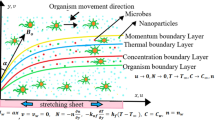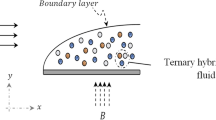Abstract
The behaviour of energy polydisperse 2d Lennard–Jones fluid (in thin-film geometry) is studied subjected to linear flow field using molecular dynamics simulations. By considering neutral and selective substrates, we systematically explore the effect of flow field on particle ordering as well as response of the system. It is shown that particle density profile, spatial organisation as well as local particle identity ordering in the film are affected. Furthermore, we observe flow-induced melting associated with a decrease of effective interaction parameter, \(\langle \epsilon _i^\mathrm{eff} \rangle \), which characterises local neighbourhood identity ordering. In terms of macroscopic response, the systems exhibit both shear thinning and shear thickening, and shear thinning exponent decreases with increasing temperature and eventually attains Netwonian fluid-like behaviour at sufficiently high temperature. The onset of shear thinning is governed by the time scale of structural relaxation of the strongly attractive particles. It is found that the qualitative behaviour of the one-component LJ-fluid and energy polydisperse fluid with neutral substrates are similar in many respects, while the one with selective substrate shows differences. In the case of energy polydisperse system, the effect of having different substrate types is significantly manifested in the density profile near the interface, effective interaction parameter and in viscosity.












Similar content being viewed by others
References
P N Pusey, J. Phys. 48, 709 (1987)
S Auer and D Frenkel, Nature 413, 711 (2001)
J J Salacuse and G Stell, J. Chem. Phys. 77, 3714 (1982)
P Sollich and M E Cates, Phys. Rev. Lett. 80, 1365 (1998)
P B Warren, Phys. Rev. Lett. 80, 1369 (1998)
J J Salacuse and G Steel, J. Chem. Phys. 77, 3714 (1982)
J J Salacuse, J. Chem. Phys. 81, 2468 (1984)
P Sollich and M E Cates, Phys. Rev. Lett. 80, 1365 (1998)
P B Warren, Phys. Rev. Lett. 80, 1369 (1998)
R M L Evans, J. Chem. Phys. 114, 1915 (2001)
P Sollich, J. Phys.: Condens. Matter 14, R79 (2002)
N B Wilding et al, J. Chem. Phys. 125, 014908 (2006)
M Buzzacchi et al, Phys. Rev. E 73, 046110 (2006)
N B Wilding, P Sollich and M Bazzacchi, Phys. Rev. E 77, 011501 (2008)
W M Jacobs and D Frenkel, J. Chem. Phys. 139, 024108 (2013)
I M Sokolov, Soft Matter 8, 9043 (2012)
R Metzler and J Klafter, Phys. Rep. 339, 1 (2000)
E Barkai, Y Garini and R Metzler, Phys. Today 65, 29 (2012)
I Izeddin et al, eLife 3, e02230 (2014)
O Benichou et al, Nature Chem. 2, 472 (2010)
J-H Jeon et al, Phys. Rev. X 6, 021006 (2016)
L S Shagolsem et al, J. Chem. Phys. 142, 051104 (2015)
L S Shagolsem and Y Rabin, J. Chem. Phys. 144, 194504 (2016)
M Priya and P K Jaiswal, Phase Transitions 93(9), 895 (2020)
C H Lam, J. Stat. Mech.: Theory Exp. 2018(2), 023301 (2018)
H Y Deng, C S Lee, M Lulli, L H Zhang and C H Lam, J. Stat. Mech.: Theory and Exp. 2019(9), 094014 (2019)
I Azizi and Y Rabin, J. Chem. Phys. 150, 134502 (2019)
K Singh and Y Rabin, Phys. Rev. Lett. 123, 035502 (2019)
T S Ingebrigtsen and H Tanaka, The J. Phys. Chem. B 120(31), 7704 (2016)
T S Ingebrigtsen, T B Schroder and J C Dyre, Phys. Rev. X 2(1), 011011 (2012)
E P George, D Raabe and R O Ritchie, Nature Rev. Mater. 4(8), 515 (2019)
Y F Ye, Q Wang, J Lu, C T Liu and Y Yang, Mater. Today 19(6), 349 (2016)
A Onuki, Phase transition dynamics (Cambridge University Press, Cambridge, England, 2004)
N J Wagner and J F Brady, Phys. Today 62, 27 (2009)
E Brown et al, Nature Mater. 9, 220 (2010)
D T N Chen, Q Wen, P A Janmey, J C Crocker and A G Yodh, Annu. Rev. Condens. Matter Phys. 1, 301 (2010)
E Brown and H M Jaeger, Science 333, 1230 (2011)
E Brown and H J Jaeger, Rep. Prog. Phys. 77, 046602 (2014)
It is well known that the melting temperature (also liquid–solid relative free energy) scales as the inverse system size. However, as reported by Morris and Song, J. Chem. Phys. 116, 9352 (2002), LJ-fluid system shows no appreciable finite-size effects for \(N\) between 2000 and 16000. Furthermore, in a study by Mastny and Pablo, J. Chem. Phys. 127, 104504 (2007), it is also shown that to reduce systematic errors from finite-size effects below 1%, at least 864 particles should be considered. In view of this, the system size of \(N=2500\) particles considered here is reasonably large.
D Berthelot, C. R. Acad. Sci. Paris 126, 1703 (1889)
S J Plimpton, J. Comput. Phys. 117, 1 (1995)
M P Allen and D J Tildesley, Computer simulation of liquids (Clarendon Press, Oxford, 1987)
F F Abraham, Phys. Rep. 80, 340 (1981)
A Z Patashinsky et al, J. Phys. Chem. C 114, 20749 (2010)
M Miyahara and K E Gubbin, J. Chem. Phys. 106, 2865 (1997)
B A Kopera and M Retsch, Anal. Chem. 90(23), 13909 (2018)
S Hess, Phys. Rev. A 22, 2844 (1980)
D J Evans, H J M Hanley and S Hess, Phys. Today 37, 26 (1984)
S Hess, Int. J. Thermophys. 6, 657 (1985)
L Banetta and A Zaccone Phys. Rev. E 99, 052606 (2019)
O Hess and S Hess, Physica A 207, 517 (1994)
S Hess et al, Physica A 240, 126 (1997)
J Delhommelle, J Petravic and D J Evans, J. Chem. Phys. 120, 6117 (2004)
Acknowledgements
LS acknowledges fruitful discussion with Yitzhak Rabin.
Author information
Authors and Affiliations
Corresponding author
Rights and permissions
About this article
Cite this article
Shagolsem, L.S. Energy polydisperse 2d Lennard–Jones fluid in the presence of flow field. Pramana - J Phys 96, 182 (2022). https://doi.org/10.1007/s12043-022-02435-7
Received:
Revised:
Accepted:
Published:
DOI: https://doi.org/10.1007/s12043-022-02435-7




